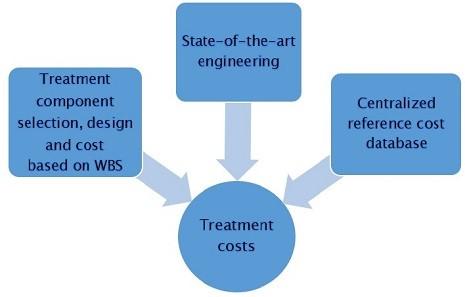Drinking Water Treatment Technology Unit Cost Models
Drinking Water Treatment Technology Unit Cost Models
Federal laws and executive orders require EPA to estimate compliance costs for new drinking water standards. The three major components of compliance costs are:
- Treatment
- Monitoring
- Administrative costs
Treatment technologies remove or destroy pollutants (such as arsenic, disinfection byproducts, and waterborne pathogens).
To estimate treatment costs, EPA developed several engineering models using a bottom-up approach known as work breakdown structure (WBS). The WBS models:
- Derive system-level costs
- Provide EPA with comprehensive, flexible and transparent tools to help estimate treatment costs
Each WBS engineering model contains a work breakdown for a particular treatment process. Engineering equations estimate equipment requirements given user-defined inputs such as design and average flow. Each model has many design assumptions (such as redundancy requirements). The models provide unit cost and total cost information by component.
The models also contain estimates of:
- Add-on costs (such as permits, pilot studies and land acquisition)
- Indirect capital costs (such as site work and contingencies)
- Annual operation and maintenance costs
Figure 1 shows the structural features used to generate treatment costs in the WBS models.
 Figure 1. Structural features used to generate treatment costs in WBS models
Figure 1. Structural features used to generate treatment costs in WBS models
The WBS models integrate these features into a series of worksheets in a Microsoft® Excel workbook for each technology. An input sheet allows users to define parameters (such as system design and average flows, target contaminant, and raw water quality). Critical design assumptions generally reflect engineering practices. Users can revise these values to reflect site-specific requirements.
WBS cost models are available to the public for the following treatment technologies:
- Granular Activated Carbon (GAC) (XLSM)(1 MB)
- GAC Documentation (PDF)(114 pp, 2.04 mb, About PDF)
- GAC is a porous adsorption media that is useful for the removal of:
- taste and odor compounds
- natural organic matter
- volatile organic compounds
- synthetic organic compounds
- disinfection byproduct precursors
- Packed Tower Aeration (PTA) (XLSM)(783 K)
- PTA Documentation (PDF)(108 pp, 1.92 mb, About PDF)
- PTA uses towers filled with a packing media to mechanically increase the area of water exposed to non-contaminated air. PTA reduces the concentration of volatile contaminants including:
- volatile organic compounds
- disinfection byproducts
- hydrogen sulfide
- carbon dioxide
- other taste-and-odor-producing compounds
- Multi-Stage Bubble Aeration (MSBA) (XLSM)(507 K)
- MSBA Documentation (PDF)(103 pp, 1.82 mb, About PDF)
- MSBA uses basins and diffusers to release small air bubbles, causing volatile contaminants to pass from the water into the air. MSBA:
- removes volatile organic compounds from source water
- improves the taste and odor of the water
- Anion Exchange (AE) (XLSM)(711 K)
- AE Documentation (PDF)(111 pp, 1.83 mb, About PDF)
- AE for Perchlorate (XLSM)(642 K, June 2019)
- AE for Perchlorate Documentation (119 pp, 4.48 mb, About PDF)
- AE removes negatively charged contaminants from water by passing it through a bed of synthetic resin. It is useful for removal of contaminants including:
- arsenic
- chromium-6
- cyanide
- perchlorate (note this requires use of a separate model above)
- nitrate
- sulfate
-
uranium
- Cation Exchange (CE) (XLSM)(575 K)
- CE Documentation (PDF)(109 pp, 1.85 mb, About PDF)
- CE removes positively charged contaminants from water by passing it through a bed of synthetic resin. It is useful for removal of contaminants including:
- barium
- chromium-3
- radium
- strontium
- hardness ions such as calcium and magnesium
- Biological Treatment (XLSM)(825 K, June 2019)
- Biological Treatment Documentation (118 pp, 4.80 mb, About PDF)
- Biological treatment of drinking water uses indigenous bacteria to remove contaminants. It is useful for removal of contaminants including nitrate and perchlorate.
- Reverse Osmosis/Nanofiltration (RO/NF) (XLSM)(978 K, June 2019)
- RO/NF Documentation (130 pp, 4.51 mb, About PDF)
- RO and NF are membrane separation processes that physically remove contaminants from water.
- RO is useful for removal of contaminants including:
- many inorganic contaminants (antimony, arsenic, barium, beryllium, cadmium, chromium, cyanide, mercury, nickel, nitrate, perchlorate, selenium)
- dissolved solids
- radionuclides
- synthetic organic chemicals
- NF is useful for removal of hardness, color and odor compounds, synthetic organic chemicals, and some disinfection byproduct precursors
- Nontreatment (XLSM)(257 K, June 2019)
- Nontreatment Documentation (102 pp, 3.71 mb, About PDF)
- Instead of treating a contaminated water source, nontreatment options replace the source with water that meets applicable drinking water standards.
- Nontreatment approaches can be useful when an alternate water source is readily available
